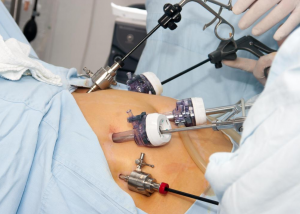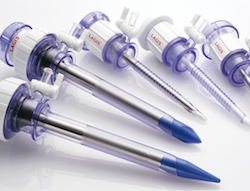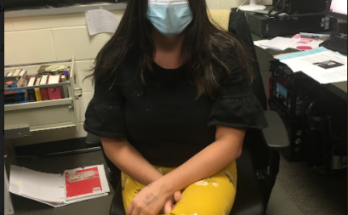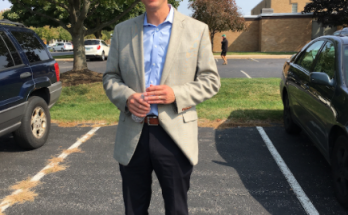Before October 18, I had never seen a live surgery. I’d watched several videos of various surgeries and procedures but had never been in the room, seeing it happen right before my eyes.
In September, Mr. Adema told our physiology class about an opportunity at Calvin College to view a live-animal surgery or a cadaver surgery. Megan Timmer and I decided to sign up together to view one of the live-animal surgeries.
On October 18, we arrived at Calvin College and were taken down to the West Michigan Regional Lab (WMRL) by one of the admissions counselors. Neither of us knew what to expect. We didn’t know what animal they would operate on or what kind of surgery they planned to perform. The mysteriousness of it all made me even more excited; I couldn’t wait to find out what we were about to see.
Down at the lab, we were met by a doctor who gave us a brief overview of the surgery: a group of third-year residents (people who had graduated from medical school and were doing graduate training) would practice a splenectomy (a removal of the spleen) on a pig, which has a similar anatomy to humans, and that there would also be physicians and maybe a couple Calvin students there. He made sure to emphasize that WMRL was committed to taking care of the animals and treating them ethically so that they didn’t suffer. Once he finished his explanation and we asked a couple questions, we were ready to put on some scrubs and head into the operating room. We were so close to viewing the actual surgery, and I couldn’t wait to see it.
Megan and I changed into scrubs and headed out into the hallway. As we put the coverings for our heads and feet on, we suddenly heard loud shrieking, like a banshee’s cries, echoing through the hallways.
“Must be the pig,” I said, trying to see where it was coming from.
“Or a pterodactyl,” Megan joked.
Turns out it was the pig. Well, one of them. We found out afterward that we were supposed to have seen the residents do surgery on one pig and practicing physicians do surgery on the other pig, but it had resisted sedation. I can’t say that I blame it.
Because of the trouble with the other pig, we had to wait a little while for the surgery to begin as they sedated the other pig. They finally brought her in, and the smell of manure hit me like a brick wall. I hadn’t been worried about getting lightheaded until that overpowering smell filled my nose. Thankfully, I ended up being fine.
For the next few minutes, the lady in charge of handling the pigs and a couple of the residents worked on tying the pig down and inserting the breathing tube. It was a little painful to watch them shove the tube into the pig’s mouth and down her throat. Finally, they got it in and everything was ready.
One of the residents cut four small incisions into the pig’s abdomen. Laparoscopic trocars were inserted into each incision and twisted through the remaining layers of skin and muscle until they entered the abdominal cavity. (No one explained any of this process to Megan and me, but it appeared that the trocars were for a device for light, a scope/camera, and surgical tools to pass through in order to enter the body.) A couple of the residents put a tube into one of the trocars and filled the pig’s abdominal cavity with carbon dioxide so that they could have more room to navigate the abdomen. A camera was then inserted into a trocar so that we could view the abdomen on a screen six inches away from the pig. We could see the organs inside with their different shapes and colors, which was fascinating. Megan told me later that she liked how she could recognize a few of the organs from the pig dissection.

Eventually, the residents and the presiding physician located the spleen and detached it from almost all of the tissue and blood vessels connected to it. They didn’t actually remove the spleen, which surprised me. Maybe someone removed the spleen afterward. I hope they did because I’m not sure how the pig would be able to live with a partially-attached organ that isn’t receiving much blood.
After they practiced the splenectomy, they practiced a nephrectomy (a removal of a kidney). The procedure was similar to that of the splenectomy: they detached the kidney from its surrounding tissue and blood vessels but didn’t remove the kidney either.
It was very interesting to watch everyone work. They all worked together to identify organs and important blood vessels and to hold for or hand over surgical instruments to the residents. The room was very crowded though since everyone was working or observing on one side and not split up between two pigs. I couldn’t see the video screen sometimes and felt a little bit like I was in the way. Nevertheless, it was a great experience. I had seen videos of laparoscopic surgery before from a perspective inside the body but had never seen one in person, so I was really interested in seeing what happened outside the body. I also enjoyed being able to watch the screen and be a few feet away as the residents operated. They used a variety of tools, one of which was a clamp that they used to burn through tissue and blood vessels, breaking through it and cauterizing it at the same time. I saw smoke on the screen. Thankfully, I didn’t smell any burning tissue, which I’m sure smells awful.
After the surgeries were finished, one of the medical residents explained what they had been doing to Megan and I, which was very kind of her. She went through the general process as well as some of the details so that we could better understand what we had just seen. After we thanked her and she left, Megan and I were suddenly in the room with only two other people; everyone else had disappeared. The pig still lay on the table, needing sutures for the incisions. The lady handling the pigs noticed us and apologized for ending the session early as a result of having only one pig instead of two. Although I wish I could have seen two surgeries, I was so glad that I even got to see just one. (I was mildly disappointed that I didn’t get to see them remove the organs. I kind of wanted to see the spleen and kidney up close.) It was an incredible experience, and I’m very grateful that Mr. Adema told us about this opportunity and that I was able to go to Calvin to view the surgery. I was also glad to not get lightheaded and to know that I could keep surgery as an option for a career. Megan was glad that she didn’t pass out and said that she actually found the surgery to be quite interesting.
If you ever get the opportunity to view a surgery at WMRL, I recommend taking it, especially if you are considering a career in healthcare. (Also, take physiology.) If you’re unsure, I recommend that you just do it because you never know if you’ll end up thinking that it’s interesting like Megan did or if you’ll decide that surgery isn’t for you. Regardless of whether you end up enjoying the surgery or not, I think you’ll still enjoy the experience overall. The staff, residents, and students there were wonderful and helped make sure that Megan and I were comfortable and that we understood at least the basics of what was going on. I hope I’ll get the opportunity to do this again and that anyone who’s interested in after reading this does as well.
And in the meantime, I hope that the pig ended up being okay.




